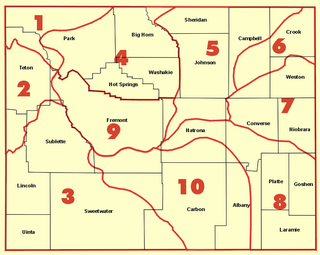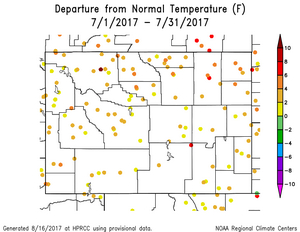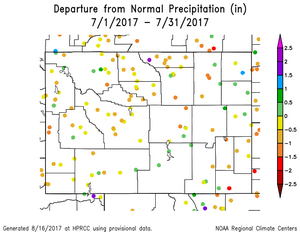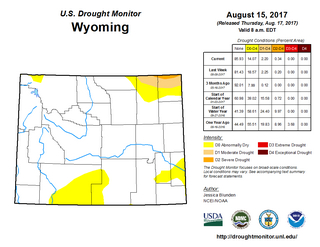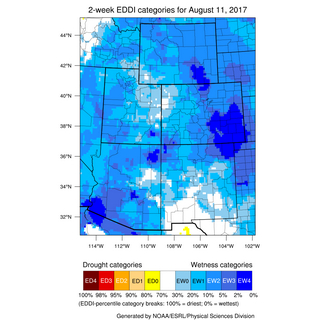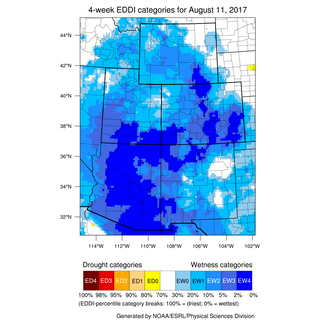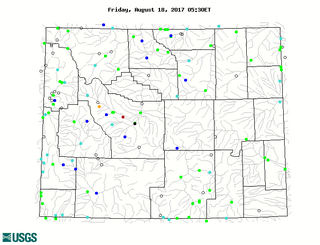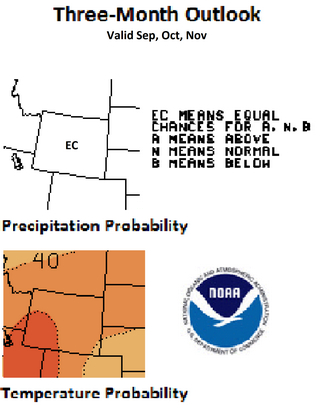 | |
 | |
| WRDS/SCO is currently working remotely so there may be a slight delay returning phone calls. Please email wrds@uwyo.edu if you are in need of information and we will respond as soon as possible |
|
| ||||||||||||
Drought Impacts and Outlook Summaries - August 2017View this Summary as a PDF
Highlights for the State
July temperatures were well-above average for most of Wyoming. The state, as a whole, ranked as the 9th warmest since 1894. The individual Climate Divisions (CD) ranged from the 6th warmest (CD 6) to the 20th warmest (CD 9). August temperatures to date (thru the 18th) are running below normal across almost the entire state with the northeast quarter having some of the coolest temperatures relative to normal. Two stations in the far west are running up to 2°F above normal. July precipitation for Wyoming was less extreme than temperature. Statewide precipitation ranked as the 27th driest of the last 123 years with CD 8 (ranking 17th) being the driest and CD 2 (exactly in the middle and ranked 62nd) being the wettest. To date (18th) the southern part of the state has seen above normal precipitation while the northern half has generally received below normal amounts this August
Drought Improvements were seen in the southwest part of Wyoming where D0 conditions were removed from Uinta County. In the southeast, D0 was removed from Albany and Laramie counties; however, there was some expansion northward into Goshen County. In the northeast, D0 was removed from Weston and Niobrara counties and the leading edges of the D1 and D2 areas were moved north a bit. D0 conditions in the southeast will likely improve while the drought in the northeast will probably persist for the near term.
Evaporative Demand Drought Index Looking at conditions over the last two weeks, the EDDI is showing low-demand conditions for the entire state. The 4-Week period ending 11 August shows that normal conditions occur in the northeast part of Wyoming with the remainder of the state having low-demand. Additional products can be found at: http://www.wrds.uwyo.edu/sitemap.html Do you have drought impacts to report? We still need your on-the-ground reports and you can input them here: http://droughtreporter.unl.edu/submitreport/
Water Resources Reservoir conditions may be viewed online at: http://www.wrds.uwyo.edu/surface_water/teacups.html Streamflows in Wyoming are running at normal or above normal. Currently only two stations in central Fremont County have below normal flows. The map below shows stream conditions in Wyoming as of August 18.
Weather and Climate Outlooks Looking further forward to the period of September through November, there are good chances for above-normal temperature statewide. Those chances are a bit higher for the southwest parts of the state. Precipitation during this period of time is uncertain for the entire state. Moving forward to October through December, there are, again, good chances for above-normal temperatures statewide. Precipitation signals are still uncertain, making for equal chances of below-normal, normal, or above-normal precipitation. Drought conditions are expected to continue in the northeast part of the state. There may be some improvement in the southeast D0 areas but no new areas are expected.
Heard around the State Sweetwater Co., Aug 9: A much-needed quarter inch of rain arrived on very gusty winds. It washed the hot air and smoke from the sky and left cool, pleasant air. Carbon Co., Aug 16: This is the first time in my reporting that the inner gauge has ran over into the outer gauge.
Partners
Stay Tuned and In Touch Live in or around the Wind River Indian Reservation? Check out the Wind River Indian Reservation and Surrounding Area Climate and Drought Summary at: WindRiverRes-Climate-Drought-Summary-Mar2017.html |
||||||||||||



